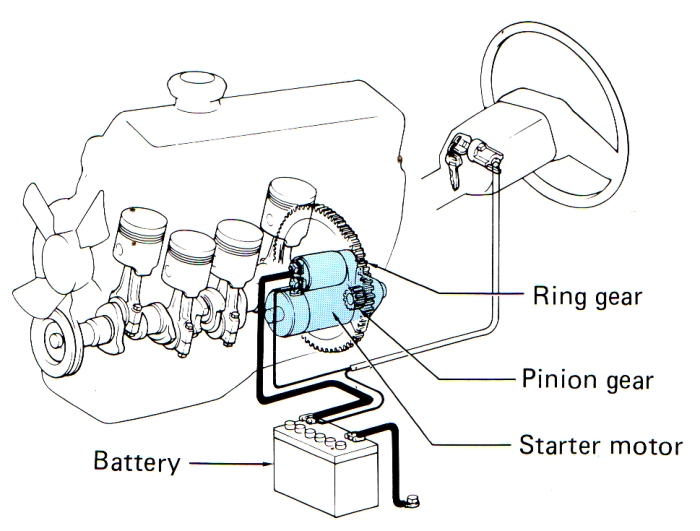Tech:Electrical/Starter Motor/The Starting System: Difference between revisions
MedicineMan (talk | contribs) No edit summary |
MedicineMan (talk | contribs) No edit summary |
||
| (10 intermediate revisions by the same user not shown) | |||
| Line 1: | Line 1: | ||
== | == The Starting System == | ||
Since the engine is not capable of starting by itself, It requires external power to crank it and help it start. Among the various means available, Automobiles now use an electric motor that has been combined with a magnetic switch that shifts a rotating pinion gear into and out of mesh with the ring gear on the circumference of the engine flywheel. | Since the engine is not capable of starting by itself, It requires external power to crank it and help it start. Among the various means available, Automobiles now use an electric motor that has been combined with a magnetic switch that shifts a rotating pinion gear into and out of mesh with the ring gear on the circumference of the engine flywheel. | ||
| Line 17: | Line 17: | ||
* Since it is characteristic of the starter motor that it draws a heavier current from the battery the lower its speed is, The battery may not be able to deliver enough power to the ignition system (In gasoline engines) during initial cranking, Due to the large voltage drop across the battery terminals. If this occurs, Poor ignition performance will result, Due to insufficient voltage build up in the primary winding of the ignition coil, Resulting in insufficient secondary voltage being sent to the spark plugs. | * Since it is characteristic of the starter motor that it draws a heavier current from the battery the lower its speed is, The battery may not be able to deliver enough power to the ignition system (In gasoline engines) during initial cranking, Due to the large voltage drop across the battery terminals. If this occurs, Poor ignition performance will result, Due to insufficient voltage build up in the primary winding of the ignition coil, Resulting in insufficient secondary voltage being sent to the spark plugs. | ||
[[Image:Starting System.jpg]] | |||
Back to [http://www.rollaclub.com/faq/index.php?title=Starter_Motor Starter Motor] | |||
Back to [http://www.rollaclub.com/faq/index.php?title=Main_Page Main Page] | |||
[http://www.rollaclub.com/ Rollaclub] | |||
Latest revision as of 05:02, 7 September 2008
The Starting System
Since the engine is not capable of starting by itself, It requires external power to crank it and help it start. Among the various means available, Automobiles now use an electric motor that has been combined with a magnetic switch that shifts a rotating pinion gear into and out of mesh with the ring gear on the circumference of the engine flywheel.
The starter motor must generate a large torque from the limited amount of power available from the battery. At the same time, It should be light and compact. For these reasons, A DC (Direct Current) series motor is used.
The engine is not completely started until it can continuously repeat its operational cycle of intake, compression, combustion and exhaust strokes on its own. The first step for starting the engine, Then, Is to crank the engine and induce the initial combustion cycle. The starter motor must therefore be at least cable of cranking the engine at the minimum rotational speed that is required to induce initial combustion.
The minimum cranking speed required for starting an engine differs depending on the engine's construction and operating conditions, But generally is 40 to 60 rpm for a gasoline engine and 80 to 100 RPM for a diesel engine.
Reasons why the engine will not start until its rotational speed builds up to a specific level include:
- The fuel is not completely atomized at lower speeds. In a gasoline engine, Low air intake speed interferes with carburetor operation. In the diesel engine, Low injection pump speed prevents complete atomization of the fuel.
- The temperature is too low. In a gasoline engine, A low cylinder temperature impedes fuel vaporization. In a diesel engine, Until the temperature of the air compressed inside the cylinders builds up, The fuel can fail to ignite.
- Since it is characteristic of the starter motor that it draws a heavier current from the battery the lower its speed is, The battery may not be able to deliver enough power to the ignition system (In gasoline engines) during initial cranking, Due to the large voltage drop across the battery terminals. If this occurs, Poor ignition performance will result, Due to insufficient voltage build up in the primary winding of the ignition coil, Resulting in insufficient secondary voltage being sent to the spark plugs.
Back to Starter Motor
Back to Main Page
